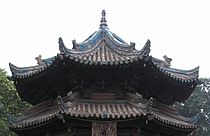Han Kitab

Multi tool use
Part of a series on
Islam in China
|
|---|
 |
History of Islam in China
By dynasty
|
|---|
|
Rebellions and revolts |
|---|
- Jahriyya revolt
- Panthay Rebellion (1856–73)
- First Dungan revolt (1862–77)
- Second Dungan revolt (1895–96)
- Afaqi Khoja revolts
|
Post-dynastic China |
|---|
|
|
Major figures
- Haji Noor
- Hu Dahai
- Hui Liangyu
- Hu Songshan
- Liu Zhi
- Ma Anliang
- Ma Bufang
- Ma Buqing
- Ma Fuxiang
- Ma Gui
- Ma Hualong
- Ma Laichi
- Ma Mingxin
- Ma Qixi
- Ma Yize
- Yeheidie'erding
- Yusuf Ma Dexin
- Wang Daiyu
- Zheng He
|
Culture
Cuisine (Uyghur)
- Han Kitab
- Mosques
- Sini
- Uyghur Arabic
- Xiao'erjing
- Islamic Association of China
|
- Hong Kong
- Kashgar
- Linxia
- Macau
- Ningxia
- Xinjiang
- Xunhua
|
Groups
- Hui
- Uyghurs
- Kazakhs
- Dongxiangs
- Kyrgyz
- Salar
- Bonans
- Tajiks
- Uzbeks
- Tatars
- Utsul
- Tibetans
|
 Islam in China portal Islam in China portal
|
|
The Han Kitab (simplified Chinese: 汉克塔布; traditional Chinese: 漢克塔布; pinyin: Hàn kètǎbù; Arabic: هان کتاب) was a collection of Chinese Islamic texts, written by Chinese Muslims, which synthesized Islam and Confucianism. It was written in the early 18th century during the Qing dynasty. Its name is similarly synthesised: 'Han' is the Chinese word for Chinese, and 'kitab' means book in Arabic.[1]Liu Zhi wrote his Han Kitab in Nanjing in the early 18th century. The works of Wu Sunqie, Zhang Zhong, and Wang Daiyu were also included in the Han Kitab.[2]
The Han Kitab was widely read and approved of by later Chinese Muslims such as Ma Qixi, Ma Fuxiang, and Hu Songshan. They believed that Islam could be understood through Confucianism.[citation needed]
References
^ Michael Dillon (1999). China's Muslim Hui community: migration, settlement and sects. Richmond: Curzon Press. p. 131. ISBN 0-7007-1026-4. Retrieved 2010-06-28..mw-parser-output cite.citation{font-style:inherit}.mw-parser-output q{quotes:"""""""'""'"}.mw-parser-output code.cs1-code{color:inherit;background:inherit;border:inherit;padding:inherit}.mw-parser-output .cs1-lock-free a{background:url("//upload.wikimedia.org/wikipedia/commons/thumb/6/65/Lock-green.svg/9px-Lock-green.svg.png")no-repeat;background-position:right .1em center}.mw-parser-output .cs1-lock-limited a,.mw-parser-output .cs1-lock-registration a{background:url("//upload.wikimedia.org/wikipedia/commons/thumb/d/d6/Lock-gray-alt-2.svg/9px-Lock-gray-alt-2.svg.png")no-repeat;background-position:right .1em center}.mw-parser-output .cs1-lock-subscription a{background:url("//upload.wikimedia.org/wikipedia/commons/thumb/a/aa/Lock-red-alt-2.svg/9px-Lock-red-alt-2.svg.png")no-repeat;background-position:right .1em center}.mw-parser-output .cs1-subscription,.mw-parser-output .cs1-registration{color:#555}.mw-parser-output .cs1-subscription span,.mw-parser-output .cs1-registration span{border-bottom:1px dotted;cursor:help}.mw-parser-output .cs1-hidden-error{display:none;font-size:100%}.mw-parser-output .cs1-visible-error{font-size:100%}.mw-parser-output .cs1-subscription,.mw-parser-output .cs1-registration,.mw-parser-output .cs1-format{font-size:95%}.mw-parser-output .cs1-kern-left,.mw-parser-output .cs1-kern-wl-left{padding-left:0.2em}.mw-parser-output .cs1-kern-right,.mw-parser-output .cs1-kern-wl-right{padding-right:0.2em}
^ Jonathan Neaman Lipman (2004). Familiar strangers: a history of Muslims in Northwest China. Seattle: University of Washington Press. p. 79. ISBN 0-295-97644-6. Retrieved 2010-06-28.
Confucian texts and Chinese Classics
|
|---|
| Four Books |
- Great Learning
- Doctrine of the Mean
- Analects
- Mencius
|
| Five Classics |
- Classic of Poetry
- Book of Documents
- Book of Rites
- I Ching
- Spring and Autumn Annals
|
| Three Commentaries |
- Commentary of Zuo
- Commentary of Gongyang
- Commentary of Guliang
|
| Thirteen Classics |
- Classic of Poetry
- Book of Documents
- Rites of Zhou
- Etiquette and Rites
- Book of Rites
- I Ching
- Commentary of Zuo
- Commentary of Gongyang
- Commentary of Guliang
- Analects
- Erya
- Classic of Filial Piety
- Mencius
|
| San Bai Qian |
- Three Character Classic
- Hundred Family Surnames
- Thousand Character Classic
|
| Chinese military classics |
- The Art of War
- Thirty-Six Stratagems
- The Methods of the Sima
- Six Secret Teachings
- Wei Liaozi
- Wu Zi
- Three Strategies of Huang Shigong
- Questions and Replies between Tang Taizong and Li Weigong
|
| Mathematics |
- The Nine Chapters on the Mathematical Art
|
| Others |
- Biographies of Exemplary Women
- Classic of Music
- School Sayings of Confucius
- The Twenty-four Filial Exemplars
- Xunzi
|
D ZeTIsgM tfLqitOBiKaZvKxlgyDMT8v,NLFnY8xI,ZOi0bqe,2lhXyTxlGUTwSqcGiS,TbpgfD
Popular posts from this blog
"Italian restaurant" redirects here. For the television series, see Italian Restaurant. Some typical Italian gastronomic products in a window display in Imola Pizza is one of the world's most popular foods and a common fast food item Part of a series on the Culture of Italy History People Languages Traditions Mythology and folklore Mythology folklore Cuisine Festivals Religion Art Literature Music and performing arts Music Media Television Cinema Sport Monuments World Heritage Sites Symbols Flag Coat of arms Italy portal v t e Italian cuisine History Ancient Roman cuisine Medieval cuisine Early modern cuisine Contemporary cuisine Regional cuisines Apulian cuisine Lombard cuisine Neapolitan cuisine Roman cuisine Sicilian cuisine Venetian cuisine Cuisine of Abruzzo Cuisine of Sardinia Lists Chefs Dishes Pas...
Part of a series on Bulgarians .mw-parser-output .nobold{font-weight:normal} българи Culture Literature Music Art Cinema Names Cuisine Dances Costume Sport Public holidays in Bulgaria By country Albania Australia Canada Czechoslovakia Greece New Zealand Romania Serbia South America Turkey Ukraine United States Bulgarian citizens France Germany Hungary Italy Lebanon Lithuania Macedonia Spain United Kingdom Subgroups Anatolian Balkanian Banat Bulgarians Bessarabian Bulgarian Dobrujans Macedonian Ruptsi Balkandzhii Pomaks (Bulgarian Muslims) Thracian Shopi/Torlaks Şchei Religion Bulgarian Orthodox Church Islam Catholic Church Protestant denominations Language Bulgarian Dialects Banat Bulgarian Other List of Bulgarians People of Bulgarian descent v t e Tarator is a cold soup made of yogurt, water, minced cucumber, dill, garlic, and sunflower or olive oil (Chips are...
This article is about the men's Ashes cricket contest. For the women's Ashes series, see Australian women's cricket team in England in 2005. 2005 Ashes series Part of the Australian cricket team in England in 2005 A ticker-tape reception for the victorious England players Date 21 July 2005 – 12 September 2005 Location England Result England won the five-Test series 2–1 Player of the series Andrew Flintoff (Eng) and Shane Warne (Aus) Compton–Miller Medal: Andrew Flintoff (Eng) Teams England Australia Captains Michael Vaughan Ricky Ponting Most runs Kevin Pietersen (473) Marcus Trescothick (431) Andrew Flintoff (402) Justin Langer (394) Ricky Ponting (359) Michael Clarke (335) Most wickets Andrew Flintoff (24) Simon Jones (18) Steve Harmison (17) Shane Warne (40) Brett Lee (20) Glenn McGrath (19) ← 2002–03 2006–07 → The 2005 Ashes series was that year's edition of...

